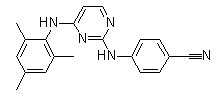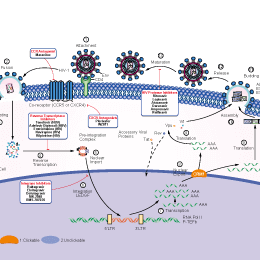
- Bioactive Compounds
- By Signaling Pathways
- PI3K/Akt/mTOR
- Epigenetics
- Methylation
- Immunology & Inflammation
- Protein Tyrosine Kinase
- Angiogenesis
- Apoptosis
- Autophagy
- ER stress & UPR
- JAK/STAT
- MAPK
- Cytoskeletal Signaling
- Cell Cycle
- TGF-beta/Smad
- DNA Damage/DNA Repair
- Compound Libraries
- Popular Compound Libraries
- Customize Library
- Clinical and FDA-approved Related
- Bioactive Compound Libraries
- Inhibitor Related
- Natural Product Related
- Metabolism Related
- Cell Death Related
- By Signaling Pathway
- By Disease
- Anti-infection and Antiviral Related
- Neuronal and Immunology Related
- Fragment and Covalent Related
- FDA-approved Drug Library
- FDA-approved & Passed Phase I Drug Library
- Preclinical/Clinical Compound Library
- Bioactive Compound Library-I
- Bioactive Compound Library-Ⅱ
- Kinase Inhibitor Library
- Express-Pick Library
- Natural Product Library
- Human Endogenous Metabolite Compound Library
- Alkaloid Compound LibraryNew
- Angiogenesis Related compound Library
- Anti-Aging Compound Library
- Anti-alzheimer Disease Compound Library
- Antibiotics compound Library
- Anti-cancer Compound Library
- Anti-cancer Compound Library-Ⅱ
- Anti-cancer Metabolism Compound Library
- Anti-Cardiovascular Disease Compound Library
- Anti-diabetic Compound Library
- Anti-infection Compound Library
- Antioxidant Compound Library
- Anti-parasitic Compound Library
- Antiviral Compound Library
- Apoptosis Compound Library
- Autophagy Compound Library
- Calcium Channel Blocker LibraryNew
- Cambridge Cancer Compound Library
- Carbohydrate Metabolism Compound LibraryNew
- Cell Cycle compound library
- CNS-Penetrant Compound Library
- Covalent Inhibitor Library
- Cytokine Inhibitor LibraryNew
- Cytoskeletal Signaling Pathway Compound Library
- DNA Damage/DNA Repair compound Library
- Drug-like Compound Library
- Endoplasmic Reticulum Stress Compound Library
- Epigenetics Compound Library
- Exosome Secretion Related Compound LibraryNew
- FDA-approved Anticancer Drug LibraryNew
- Ferroptosis Compound Library
- Flavonoid Compound Library
- Fragment Library
- Glutamine Metabolism Compound Library
- Glycolysis Compound Library
- GPCR Compound Library
- Gut Microbial Metabolite Library
- HIF-1 Signaling Pathway Compound Library
- Highly Selective Inhibitor Library
- Histone modification compound library
- HTS Library for Drug Discovery
- Human Hormone Related Compound LibraryNew
- Human Transcription Factor Compound LibraryNew
- Immunology/Inflammation Compound Library
- Inhibitor Library
- Ion Channel Ligand Library
- JAK/STAT compound library
- Lipid Metabolism Compound LibraryNew
- Macrocyclic Compound Library
- MAPK Inhibitor Library
- Medicine Food Homology Compound Library
- Metabolism Compound Library
- Methylation Compound Library
- Mouse Metabolite Compound LibraryNew
- Natural Organic Compound Library
- Neuronal Signaling Compound Library
- NF-κB Signaling Compound Library
- Nucleoside Analogue Library
- Obesity Compound Library
- Oxidative Stress Compound LibraryNew
- Plant Extract Library
- Phenotypic Screening Library
- PI3K/Akt Inhibitor Library
- Protease Inhibitor Library
- Protein-protein Interaction Inhibitor Library
- Pyroptosis Compound Library
- Small Molecule Immuno-Oncology Compound Library
- Mitochondria-Targeted Compound LibraryNew
- Stem Cell Differentiation Compound LibraryNew
- Stem Cell Signaling Compound Library
- Natural Phenol Compound LibraryNew
- Natural Terpenoid Compound LibraryNew
- TGF-beta/Smad compound library
- Traditional Chinese Medicine Library
- Tyrosine Kinase Inhibitor Library
- Ubiquitination Compound Library
-
Cherry Picking
You can personalize your library with chemicals from within Selleck's inventory. Build the right library for your research endeavors by choosing from compounds in all of our available libraries.
Please contact us at [email protected] to customize your library.
You could select:
- Antibodies
- Bioreagents
- qPCR
- 2x SYBR Green qPCR Master Mix
- 2x SYBR Green qPCR Master Mix(Low ROX)
- 2x SYBR Green qPCR Master Mix(High ROX)
- Protein Assay
- Protein A/G Magnetic Beads for IP
- Anti-Flag magnetic beads
- Anti-Flag Affinity Gel
- Anti-Myc magnetic beads
- Anti-HA magnetic beads
- Magnetic Separator
- Poly DYKDDDDK Tag Peptide lyophilized powder
- Protease Inhibitor Cocktail
- Protease Inhibitor Cocktail (EDTA-Free, 100X in DMSO)
- Phosphatase Inhibitor Cocktail (2 Tubes, 100X)
- Cell Biology
- Cell Counting Kit-8 (CCK-8)
- Animal Experiment
- Mouse Direct PCR Kit (For Genotyping)
- New Products
- Contact Us
Dapivirine (TMC120)
Dapivirine (TMC120) is a non-nucleoside inhibitor for HIV reverse transcriptase with IC50 of 24 nM, inhibits a broad panel of HIV-1 isolates from different classes, inclucing a wide range of NNRTI-resistant isolates. Phase 3.

Dapivirine (TMC120) Chemical Structure
CAS No. 244767-67-7
Purity & Quality Control
Dapivirine (TMC120) Related Products
| Related Targets | HBV RT HIV RT RT | Click to Expand |
|---|---|---|
| Related Products | Salicylanilide Fangchinoline | Click to Expand |
| Related Compound Libraries | Anti-infection Compound Library Antibiotics compound Library Antiviral Compound Library Anti-parasitic Compound Library Gut Microbial Metabolite Library | Click to Expand |
Signaling Pathway
Biological Activity
| Description | Dapivirine (TMC120) is a non-nucleoside inhibitor for HIV reverse transcriptase with IC50 of 24 nM, inhibits a broad panel of HIV-1 isolates from different classes, inclucing a wide range of NNRTI-resistant isolates. Phase 3. | ||
|---|---|---|---|
| Targets |
|
| In vitro | ||||
| In vitro | Dapivirine prevents HIV-induced syncytium formation in the nanomolar range and shows a low cytostatic activity. Dapivirine apparently blocks HIV-1 infection in the primary cultures at a 10 nM concentration, but secondary cultures reveals that a 100 nM concentration is needed to completely prevent proviral integration. [1] Dapivirine is well tolerated by epithelial cells, T cells, macrophages, and cervical tissue explants with CC50 (50% cytotoxic concentration) of 10 μM to 20 μM. Dapivirine potently inhibits infection by both X4- and R5-utilizing HIV-1 strains with IC50 of 1.46 nM in cell-based assays. Dapivirine potently inhibits HIV-1BaL infection of human ectocervical explant tissue in a dose-dependent manner, as evaluated by the reduction in both p24 release and provirus content in cultured explants. Dapivirine inhibits the transmission of virus to permissive T cells in a dose-dependent manner, with an IC50 of 0.1 nM. Dapivirine results in significant inhibition of HIV infection when explants are challenged with virus immediately with IC90 of 100 nM. Dapivirine is also able to inhibit viral dissemination by migratory cells. [2] | |||
|---|---|---|---|---|
| In Vivo | ||
| In vivo | Dapivirine-containing gel at vaginal level inhibits cell-associated HIV infection in mice. [3] More placebo (7 of 12) than Dapivirine (3 of 24) gel users has positive vaginal swab results, with white blood cells being the most common finding. Dapivirine (0.05%) results in Cmax of 715 pg/mL, AUC of 15 ng×h/mL and T1/2 of 89.87 hours in plasma after 14 days post-dose. Mean Dapivirine (0.05%) concentrations in vaginal fluids collected at the introitus, mid vagina, and cervix are in the range of 62-265 μg/g on day 1. [4] | |
|---|---|---|
| NCT Number | Recruitment | Conditions | Sponsor/Collaborators | Start Date | Phases |
|---|---|---|---|---|---|
| NCT05416021 | Active not recruiting | HIV Infections |
International Partnership for Microbicides Inc. |
August 1 2022 | Phase 1 |
| NCT03593655 | Completed | HIV Infections |
National Institute of Allergy and Infectious Diseases (NIAID) |
January 14 2019 | Phase 2 |
| NCT03393468 | Completed | HIV Infections |
National Institute of Allergy and Infectious Diseases (NIAID) |
May 10 2018 | Phase 1 |
| NCT03239483 | Completed | HIV Infections |
National Institute of Allergy and Infectious Diseases (NIAID) |
October 26 2017 | Phase 1 |
Chemical Information & Solubility
| Molecular Weight | 329.4 | Formula | C20H19N5 |
| CAS No. | 244767-67-7 | SDF | Download Dapivirine (TMC120) SDF |
| Smiles | CC1=CC(=C(C(=C1)C)NC2=NC(=NC=C2)NC3=CC=C(C=C3)C#N)C | ||
| Storage (From the date of receipt) | |||
|
In vitro |
DMSO : 34 mg/mL ( (103.21 mM) Moisture-absorbing DMSO reduces solubility. Please use fresh DMSO.) Water : Insoluble Ethanol : Insoluble |
Molecular Weight Calculator |
|
In vivo Add solvents to the product individually and in order. |
In vivo Formulation Calculator |
||||
Preparing Stock Solutions
Molarity Calculator
In vivo Formulation Calculator (Clear solution)
Step 1: Enter information below (Recommended: An additional animal making an allowance for loss during the experiment)
mg/kg
g
μL
Step 2: Enter the in vivo formulation (This is only the calculator, not formulation. Please contact us first if there is no in vivo formulation at the solubility Section.)
% DMSO
%
% Tween 80
% ddH2O
%DMSO
%
Calculation results:
Working concentration: mg/ml;
Method for preparing DMSO master liquid: mg drug pre-dissolved in μL DMSO ( Master liquid concentration mg/mL, Please contact us first if the concentration exceeds the DMSO solubility of the batch of drug. )
Method for preparing in vivo formulation: Take μL DMSO master liquid, next addμL PEG300, mix and clarify, next addμL Tween 80, mix and clarify, next add μL ddH2O, mix and clarify.
Method for preparing in vivo formulation: Take μL DMSO master liquid, next add μL Corn oil, mix and clarify.
Note: 1. Please make sure the liquid is clear before adding the next solvent.
2. Be sure to add the solvent(s) in order. You must ensure that the solution obtained, in the previous addition, is a clear solution before proceeding to add the next solvent. Physical methods such
as vortex, ultrasound or hot water bath can be used to aid dissolving.
Tech Support
Answers to questions you may have can be found in the inhibitor handling instructions. Topics include how to prepare stock solutions, how to store inhibitors, and issues that need special attention for cell-based assays and animal experiments.
Tel: +1-832-582-8158 Ext:3
If you have any other enquiries, please leave a message.
* Indicates a Required Field
Tags: buy Dapivirine (TMC120) | Dapivirine (TMC120) supplier | purchase Dapivirine (TMC120) | Dapivirine (TMC120) cost | Dapivirine (TMC120) manufacturer | order Dapivirine (TMC120) | Dapivirine (TMC120) distributor







































